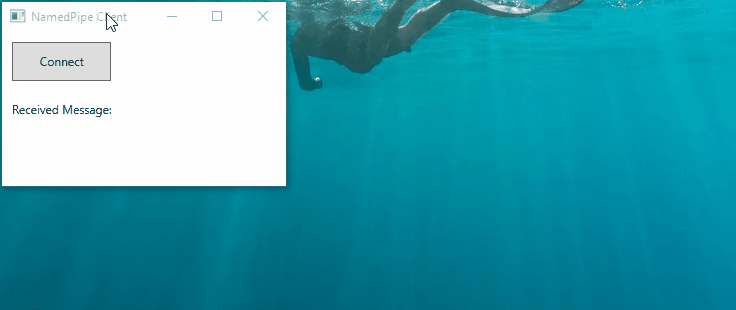最近在一次项目中使用到了C#中命名管道,所以在此写下一篇小结备忘。
为什么要使用命名管道呢?为了实现两个程序之间的数据交换。假设下面一个场景。在同一台PC上,程序A与程序B需要进行数据通信,此时我们就可以使用命名管道技术来实现。命名管道的两个对象。NamedPipeClientStream 和 NamedPipeServerStream 对象。请求通信的一方为Client端,发送数据的一方为Server端。
使用NamedPipe来通信,如果Server端崩溃了,不会影响到客户端。
下面我们通过一个例子来说明:
Server端:
UI:
<Grid>
<Grid.RowDefinitions>
<RowDefinition Height="*"/>
<RowDefinition Height="Auto"/>
<RowDefinition Height="Auto"/>
<RowDefinition Height="*"/>
</Grid.RowDefinitions>
<Grid.ColumnDefinitions>
<ColumnDefinition Width="Auto"/>
<ColumnDefinition Width="*"/>
</Grid.ColumnDefinitions>
<TextBlock Text="Received Message:" Grid.Row="1" Margin="10"/>
<TextBlock x:Name="tblRecMsg" VerticalAlignment="Center" Grid.Row="1" Grid.Column="1"/>
<Button Content="Send" Grid.Row="2" Margin="10" Click="OnSend"/>
<TextBox x:Name="txtSendMsg" VerticalAlignment="Center" Grid.Row="2" Grid.Column="1" Margin="10"/>
</Grid>
Code:
private NamedPipeServerStream _pipe;
private const string PipeName = "PipeSample";
private const int PipeInBufferSize = 4096;
private const int PipeOutBufferSize = 65535;
private Encoding encoding = Encoding.UTF8;
public MainWindow()
{
InitializeComponent();
_pipe = new NamedPipeServerStream
(
PipeName,
PipeDirection.InOut,
1,
PipeTransmissionMode.Message,
PipeOptions.Asynchronous | PipeOptions.WriteThrough,
PipeInBufferSize,
PipeOutBufferSize
);
_pipe.BeginWaitForConnection(WaitForConnectionCallback, _pipe);
}
private void WaitForConnectionCallback(IAsyncResult ar)
{
var pipeServer = (NamedPipeServerStream)ar.AsyncState;
pipeServer.EndWaitForConnection(ar);
var data = new byte[PipeInBufferSize];
var count = pipeServer.Read(data, 0, PipeInBufferSize);
if (count > 0)
{
// 通信双方可以约定好传输内容的形式,例子中我们传输简单文本信息。
string message = encoding.GetString(data, 0, count);
Dispatcher.BeginInvoke(new Action(() =>
{
tblRecMsg.Text = message;
}));
}
}
private void OnSend(object sender, RoutedEventArgs e)
{
if (_pipe.IsConnected)
{
try
{
string message = txtSendMsg.Text;
byte[] data = encoding.GetBytes(message);
_pipe.Write(data, 0, data.Length);
_pipe.Flush();
_pipe.WaitForPipeDrain();
}
catch { }
}
Close();
}
Client端:
UI:
<Grid>
<Grid.RowDefinitions>
<RowDefinition Height="*"/>
<RowDefinition Height="Auto"/>
<RowDefinition Height="Auto"/>
<RowDefinition Height="*"/>
</Grid.RowDefinitions>
<Grid.ColumnDefinitions>
<ColumnDefinition Width="Auto"/>
<ColumnDefinition Width="*"/>
</Grid.ColumnDefinitions>
<Button Content="Connect" Margin="10" Click="OnConnect"/>
<TextBlock Text="Received Message:" Grid.Row="1" Margin="10"/>
<TextBlock x:Name="tblRecMsg" Grid.Row="1" Grid.Column="1"/>
</Grid>
Code:
private const string PipeServerName = "PipeServer.exe";
private const string PipeName = "PipeSample";
private Encoding encoding = Encoding.UTF8;
private NamedPipeClientStream _pipe;
private bool _starting = false;
public MainWindow()
{
InitializeComponent();
}
private void OnConnect(object sender, RoutedEventArgs e)
{
if (_starting)
{
return;
}
var path = System.IO.Path.Combine(System.AppDomain.CurrentDomain.BaseDirectory, PipeServerName);
var startInfo = new ProcessStartInfo(path)
{
UseShellExecute = false,
CreateNoWindow = true
};
try
{
var process = Process.Start(startInfo);
_pipe = new NamedPipeClientStream
(
".",
PipeName,
PipeDirection.InOut,
PipeOptions.Asynchronous | PipeOptions.WriteThrough
);
_pipe.Connect();
_pipe.ReadMode = PipeTransmissionMode.Message;
string message = "Connected!";
byte[] data = encoding.GetBytes(message);
_pipe.BeginWrite(data, 0, data.Length, PipeWriteCallback, _pipe);
_starting = true;
}
catch (Exception ex)
{
Debug.Write(ex.StackTrace);
}
}
private void PipeWriteCallback(IAsyncResult ar)
{
var pipe = (NamedPipeClientStream)ar.AsyncState;
pipe.EndWrite(ar);
pipe.Flush();
pipe.WaitForPipeDrain();
var data = new byte[65535];
var count = pipe.Read(data, 0, data.Length);
if (count > 0)
{
string message = encoding.GetString(data, 0, count);
Dispatcher.BeginInvoke(new Action(() => {
tblRecMsg.Text = message;
}));
}
}
需要注意的地方:因为我们在同一台PC上面进行通信,我们只需要将 NamedPipeClientStream 构造参数中pipeServer设为"."即可。另外因为这只是一个示例,所以PipeServer中只传递简单String类型。当然也可以传递其他类型的内容。
运行效果:

感谢您的阅读!